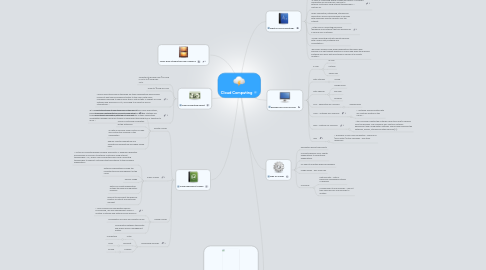
1. Cloud Computing Market
1.1. Projected to double from $45-60B in 2010 to $148.8 B by 2014
1.2. Grow to $240B by 2020
1.3. "Senior executives around the globe say their organizations have already moved at least some business activities to the cloud, with some companies planning to spend more than a fifth of their IT budget on cloud software and services in 2012, according to a report by KPMG International. "
1.4. "81 percent of participants said they were either evaluating cloud applications, planned a cloud implementation, or had already adopted a cloud strategy and timeline for their organization, with almost one-quarter of them saying their organization already runs all of its core IT services on the cloud or is in transition to do so. "
2. Cloud Depolyment Models
2.1. Private Clouds
2.1.1. "A private cloud is a new model for IT delivery. It transforms datacenter resources to enable the key benefits of cloud computing..." Microsoft
2.1.2. Cloud is controlled completely by the enterprise
2.1.3. All data in resource under control of legal and contractual umbrella of the organization
2.1.4. Require Capital Expenditure and Operational Expenditure and highly skilled labor
2.2. Public Clouds
2.2.1. "...a style of computing where scalable and elastic IT-enabled capabilities are provided as a service to external customers using Internet technologies—i.e., public cloud computing uses cloud computing technologies to support customers that are external to the provider’s organization."
2.2.2. External organizations provide the infrastructure and management of the cloud
2.2.3. Pay per Usage
2.2.4. Data in an offsite organization outside the legal and regulatory umbrella
2.2.5. Difficult to document the physical location of data at any particular moment
2.3. Hybrid Clouds
2.3.1. "...policy-based and coordinated service provisioning, use and management across a mixture of internal and external cloud services."
2.3.2. Combination of Public and Private Clouds
2.3.3. Coordination between the private and public service management system
2.4. Technology provider
2.4.1. Citrix
2.4.1.1. CloudStack
2.4.2. Microsoft
2.4.2.1. Azuel
2.4.3. VMware
2.4.3.1. vCloud
3. Video: Brief introduction from Saleforce
4. What does this mean for me?
5. What is Cloud Computing?
5.1. “An emerging IT development, deployment and delivery model enabling real-time delivery of products, services and solutions over the Internet.” – IDC Research
5.2. “A style of computing where scalable and elastic IT-enabled capabilities are provided as a service to external customers using Internet technologies.” – Gartner Inc.
5.3. When computing, networking, storage and application services are provided as services with seemingly infinite capacity over the Internet.
5.4. ...is the use of computing resources (hardware and software) that are delivered as a service over a network.
5.5. "Cloud computing entrusts remote services with a user's data, software and computation."
5.6. "End users access cloud-based applications through a web browser or a light-weight desktop or mobile app while the business software and user's data are stored on servers at a remote location."
6. Examples of Cloud Services
6.1. E-Mail
6.1.1. G-Mail
6.1.2. Hotmail
6.1.3. Yahoo Mail
6.2. Data Storage
6.2.1. iCloud
6.3. Data Sharing
6.3.1. Google Drive
6.3.2. Box.com
6.3.3. Dropbox
6.4. ASP - Application as a Service
6.4.1. Google Apps
6.5. SaaS - Software as a aService
6.5.1. "...software and associated data are centrally hosted on the cloud..."
6.6. PaaS - Platform as a Service
6.6.1. ..."the consumer creates the software using tools and/or libraries from the provider. The consumer also controls software deployment and configuration settings. The provider provides the networks, servers, storage and other services.[1]"
6.7. IaaS
6.7.1. "...providers of IaaS offer computers - physical or (more often) virtual machines - and other resources."
7. Why Go Cloud?
7.1. Eliminates upfront fixed costs
7.2. Convert expenses from Capital Expenditures to Operational Expenditures
7.3. No need to maintain physical hardware
7.4. Usage driven - buy as you go
7.5. Concerns:
7.5.1. Data Security - Data is physically somewhere outside of premise
7.5.2. Locked down to one provider - can not take services from one provider to another
